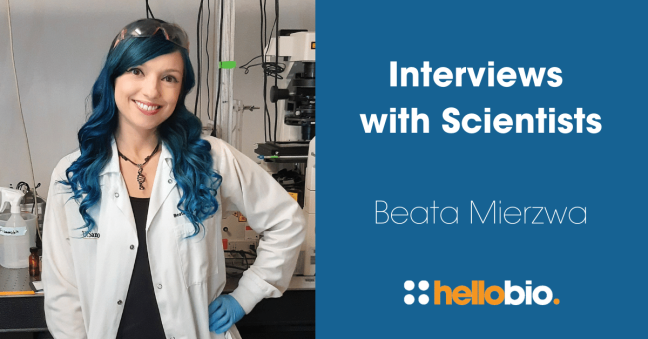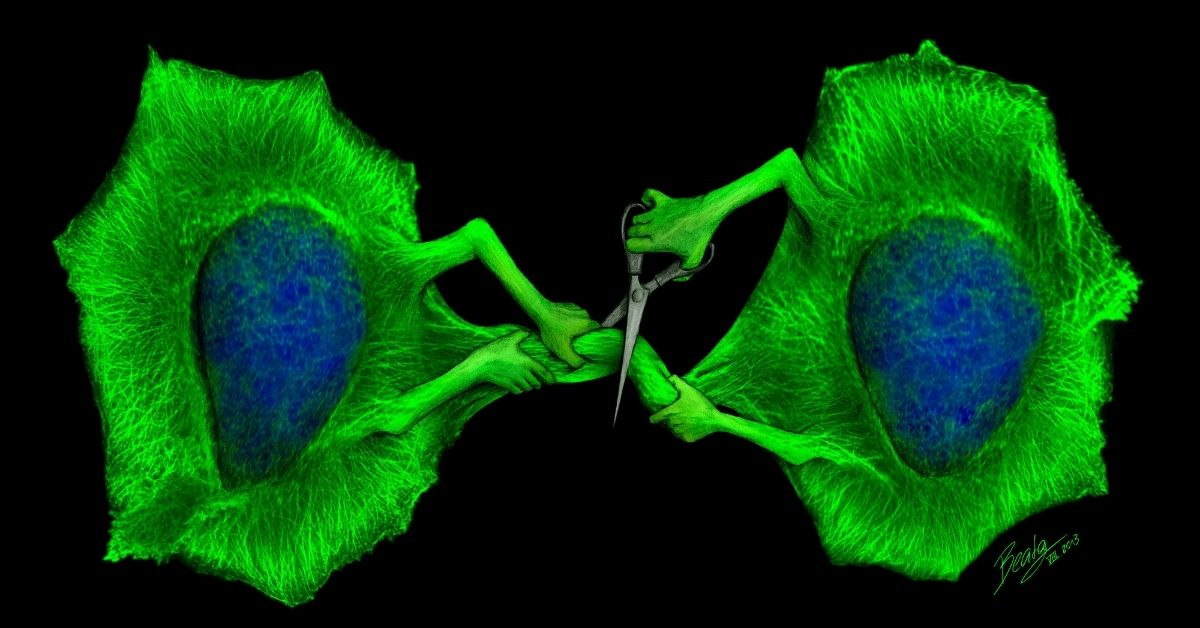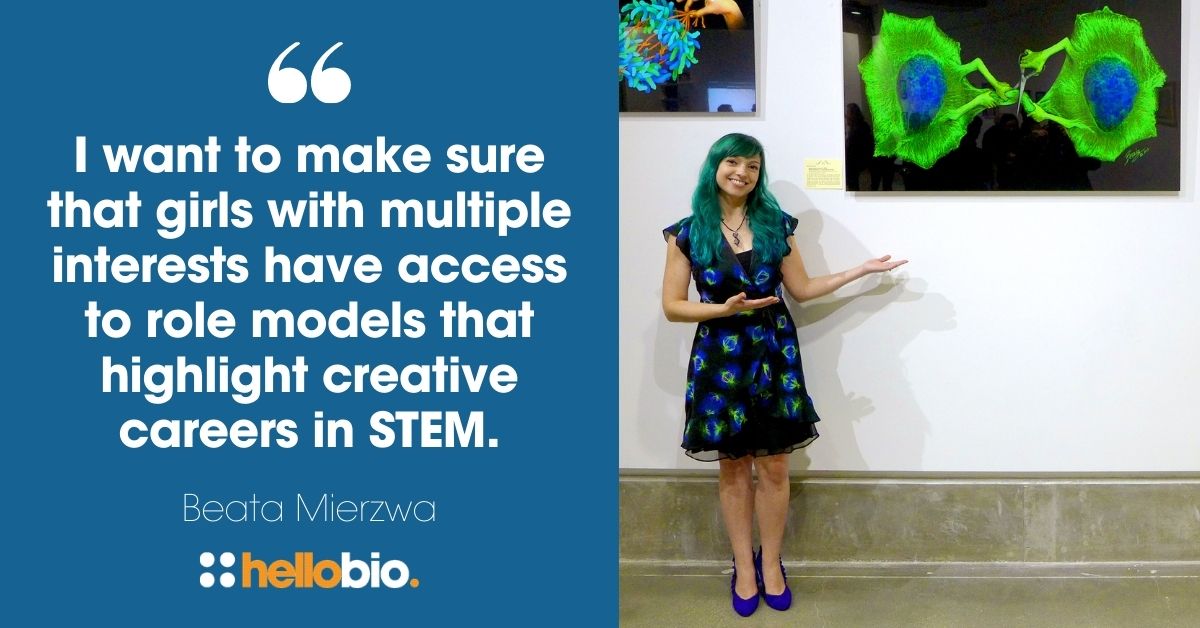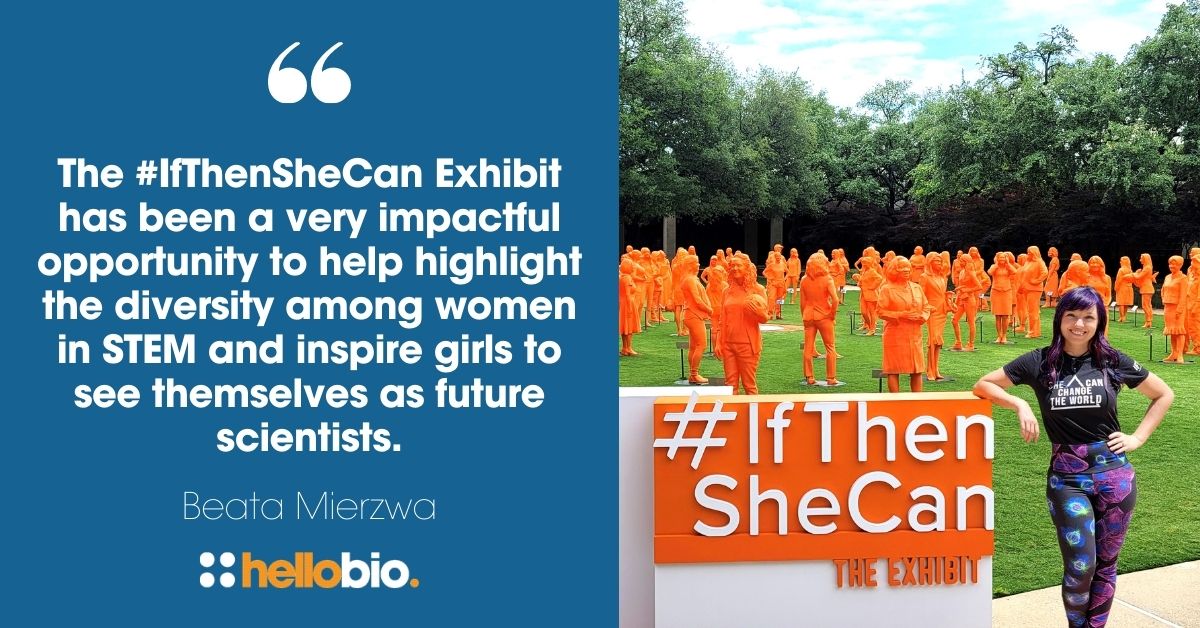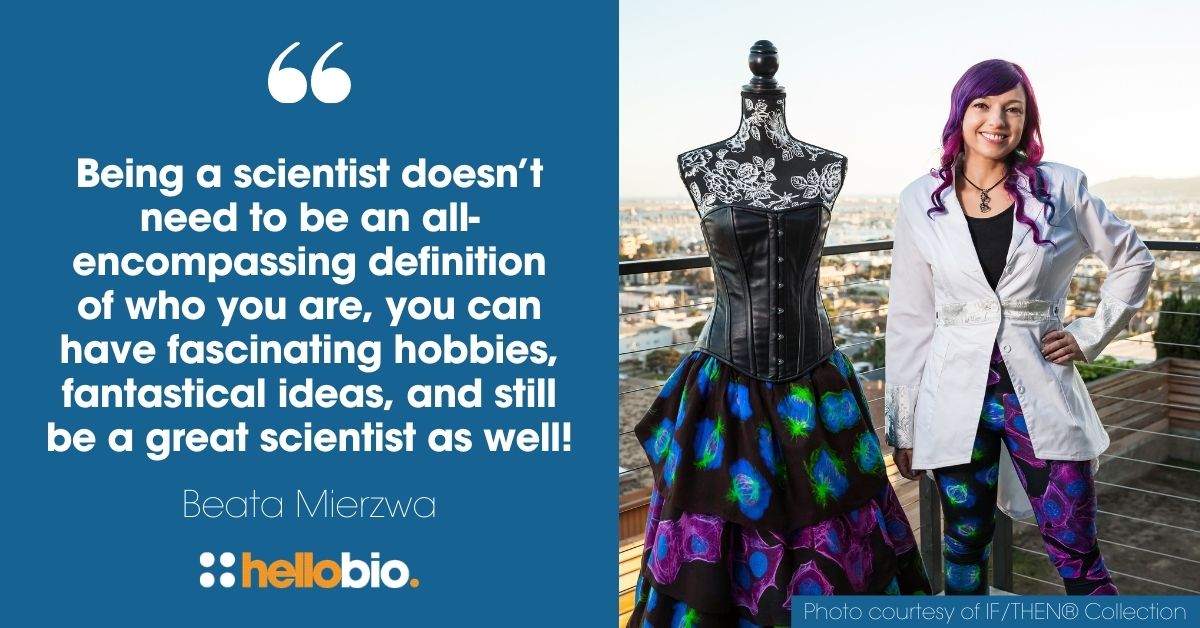Interviews with Scientists: Beata Mierzwa
In the next in our Interviews with Scientists series, we spoke to Beata Mierzwa, a Molecular Biologist and Science Artist at the Ludwig Institute for Cancer Research and University of California San Diego.
Beata Mierzwa studies how human cells divide and shares the beauty of science through art and fashion. Her postdoctoral research aims to advance the world’s understanding of cell division and improve cancer therapy. Beyond her academic career, Beata creates science-themed drawings and clothes. Her hand-drawn illustrations use metaphor to portray scientific concepts in intuitive ways, while her microscopy fashion celebrates the beauty of the molecular world. She also created a science video game, Microscopya, that invites players to explore the beauty inside our cells.
Through her AAAS IF/THEN Ambassadorship for science outreach and her work with Young Women in Bio – Southern California, she aims to inspire creative students to pursue careers in STEM.
We had a truly inspiring conversation with Beata in which she told us about her fascination for cell division, her drive to inspire girls in STEM, and her uniquely artistic approach to science communication…
Thanks for speaking with us, Beata! Please can you tell us a little more about your current role?
I'm currently working on my postdoctoral research at the Ludwig Institute for Cancer Research and University of California San Diego. I am fascinated by the many unresolved questions underlying cell division. After studying the mechanism of the final step in cell division during my PhD, my postdoctoral research focuses on exploring mitosis from a broader angle. I use genome-wide CRISPR screens to discover novel genes that are essential for cell division and investigate differences in requirements for mitotic entry between different types of human cells. Uncovering cell type-specific mitotic genes has the potential to identify new targets for cancer therapy.
Did you always want to work in science when you were younger, and if so why?
I always had a natural curiosity as a child, and I still hear anecdotes from my family about me asking an overwhelming amount of questions about how everything works. I first learned about molecular biology in high school and became fascinated by the wonders that make life possible, in particular the concept of how our bodies are made of cells and how our genetic code makes us who we are. This drew me to a career in the life sciences, and I started studying molecular biology before I even knew what the inside of a lab looked like. The more I learned about the complexity and interconnectedness of molecular processes, the more I realized how much there is still to discover. I fell in love with cell division when I saw my first dividing cell under the microscope and have been studying this process ever since.
What do you enjoy most about working in STEM?
I love the idea that my research helps advance human knowledge and makes a positive impact on our world. The possibility of having the chance to see something under the microscope that nobody has seen before is incredibly inspiring to me. Even though working in the lab can be challenging at times, these are the moments that are extremely rewarding for the scientist in me. I also enjoy getting to use my creativity in designing experiments and exploring unconventional ways to communicate my research.
You are passionate about science communication. Why is this so important to you?
Science communication is a crucial part of scientific exchange and collaboration, both inside and outside the scientific community. With increasing specialization and complexity of methodologies, communicating science is key to interdisciplinary and innovative research by promoting collaboration between distinct scientific fields. Sharing scientific discoveries beyond the scientific community is just as important, and I believe that it is our responsibility as scientists to engage the public and help promote trust in the scientific method.
On a personal level, experimenting with creative approaches to science communication has transformed the way I think about and present my research. Creating illustrations for my own and other people’s research has deepened my ability to translate the essence of complex scientific findings into intuitive visuals. I love using metaphor to put abstract scientific concepts into a familiar context that anybody can relate to, allowing me to connect with broader audiences on a deeper level. It is truly fascinating to see how using visuals to explain complex material helps spark genuine interest and excellent scientific questions, and it has developed into a mission to inspire our next generation of creative scientists.
You are also a keen artist and create artwork based on scientific images. Which came first - your love of science or your love of art?
Though professionally I am a scientist first, art and creativity have been part of my life for as long as I can remember. When I was deciding what to study after high school, my three big interests were science, art, and fashion. At that time, I believed that these were mutually exclusive, and I would have never dreamed that one day I’d be able to combine all three of them to communicate science in creative ways and get people excited about biology and STEM. After studying molecular biology, I fully focused on working in the lab and never made time for creative projects. However, a few years into my PhD I got the chance to create my first science drawing about my research on the final step in cell division in which cells physically separate from each other. My drawing showed two cells holding a pair of scissors to literally cut the connection between each other. When I started using this drawing for my scientific presentations, I noticed that people would remember my research even many years later – this made me realize that visuals are an incredibly powerful tool for science communication, inspiring me to start creating illustrations for journal covers, conferences, and research groups.
You are an ambassador for the AAAS IF/THEN program. How did you get involved with this and why is it important to you?
I first learned about the AAAS IF/THEN Initiative through Ahna Skop, a Professor at the University of Wisconsin-Madison and fellow IF/THEN Ambassador. I knew her initially through her scientific work on cell division, and it was wonderful to later discover her artistic side as well. Her story of how she started the Worm Art Show at the International C. elegans Conference and has been running it for more than 20 years has been a huge inspiration for me.
The mission of IF/THEN is very close to my heart because I believe that having a role model at a young age can make a huge impact on someone’s life. I always loved both art and science, but initially I thought I had to pick between my passions to pursue a career. I didn’t have a role model at that time to demonstrate that combining them was a possibility, and it took me until halfway through my PhD to realize that I can pursue both. I want to make sure that girls with multiple interests have access to role models that highlight creative careers in STEM.
Women remain underrepresented in all fields of STEM. What more could be done to improve the gender balance in science?
I believe that creating a more equal gender balance in STEM throughout all career stages needs to start from a young age. In our education system, female students have never been heavily encouraged to pursue science, especially those who don’t fit the traditional scientific archetype. Reaching girls at a young age is particularly important, as this is a time when people begin to form their own self-image and life aspirations. Painting a more inclusive picture of what it means to be a scientist and highlighting female role models in STEM is our opportunity to challenge outdated stereotypes and shape future career choices for decades to come.
Being part of the IF/THEN Initiative has been an incredible honor. The #IfThenSheCan Exhibit has been a very impactful opportunity to help highlight the diversity among women in STEM and inspire girls to see themselves as future scientists. By highlighting the connection between science and art, I want to bring creative minds into the field for innovative research and groundbreaking discoveries.
Who has been your greatest role model, and why?
There are too many to name! I am particularly inspired by my fellow IF/THEN Ambassadors – sharing our passions for promoting women in STEM has been extremely inspiring. I believe that the Ambassadors, as well as other STEM professionals, are amazing role models not only for girls but for each other as well.
Your latest project is a science-themed video game called Microscopya. Can you tell us a little more about this and how it came to be?
When we became IF/THEN Ambassadors, each of us had the opportunity to write a grant proposal for an outreach project that we’d be passionate about. I’ve always been a huge fan of video games, and my favorite part has been experiencing the unique and fantastical worlds that they create. I often thought how amazing it would be to study game design if I had the opportunity to learn something completely new. I knew that this grant was a once-in-a-lifetime opportunity to create my own game – something I had always dreamed of, but never thought I’d actually be able to do.
The game I created is called Microscopya, and it invites the player to explore the inside of the cell, with hand-drawn illustrations and puzzles based on real scientific concepts. While the molecular principles are based on accurate scientific concepts, the cell is presented as a fantastical enchanting world, highlighting the beauty and complexity of the processes that make life possible. While enjoyable for any age group, the game aims to connect with younger audiences on a deeper level, sparking curiosity about science and bringing awareness to careers in STEM.
What's the most important lesson you have learned in your career so far?
Whatever your dream is, whether it’s science, art, or combining your own unique passions, don't be afraid to create your own path. It took me many years to realize that I can combine my passions for science and art. The most important thing I learned is to treat life like a big experiment and try new things. When I started exploring incorporating art into my research, I would have never dreamed that I would get these amazing opportunities. I learned that there is no point in waiting until you feel ‘ready’ to start a new endeavor and that as scientists, we already have the skills needed to explore something new. Being a scientist doesn’t need to be an all-encompassing definition of who you are, you can have fascinating hobbies, fantastical ideas, and still be a great scientist as well!
And finally… what’s your favourite science quote?
“It seems to me that the natural world is the greatest source of excitement; the greatest source of visual beauty; the greatest source of intellectual interest. It is the greatest source of so much in life that makes life worth living.” ― David Attenborough
_________________________________________________
Thank you so much for a fascinating interview Beata! Connect with Beata on social media and find out more about her art, research and the Microscopya video game:
Website: www.beatascienceart.com
Microscopya: www.microscopya.com
LinkedIn: Beata Mierzwa
Twitter: @beatascienceart
Instagram: @beatascienceart
Facebook: Beata Science Art
TikTok: @beatascienceart
_________________________________________________
If you enjoyed this article, why not check out the other resources available on our blog. We are passionate about supporting life scientists including early career life scientists and PhD students - with really low-priced reagents and biochemicals, early career scientist grants, and resources to help with both personal and professional development. We know how tough it is - so we hope you find these helpful!
More General Support for Life Scientists
For advice on writing papers, dissertations, presenting at conferences, wellbeing, PhD support, networking and lots more, we have a huge range of articles to help - just click below:
Save up to 50% on our high purity reagents...
When you get to the stage of planning your experiments, don't forget that we offer a range of low-cost, high-purity agonists, antagonists, inhibitors, activators, antibodies and fluorescent tools (yes - they really are around half the price of other suppliers!) You can use our Quick Multi-Search Tool to search for lots of products in one go, and the range includes:
- Enzyme inhibitors and activators
- Chemogenetic ligands
- Ion channel modulators
- GPCR & ionotropic receptor ligands
- Cell biology reagents & biochemicals
Technical resources
Try our Molarity Calculator: a quick and easy way to calculate the mass, volume or concentration required for making a solution.
Try our Dilution Calculator: an easy way to work out how to dilute stock solutions of known concentrations
And finally, don't forget to check back in with our blog regularly for our latest articles. If there’s something you’d love to contribute to the community, whether that’s an interview or article, drop us a line at hello@hellobio.com
---





